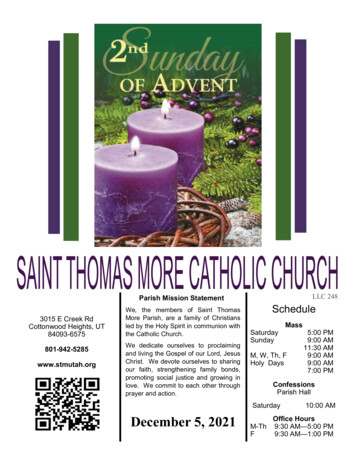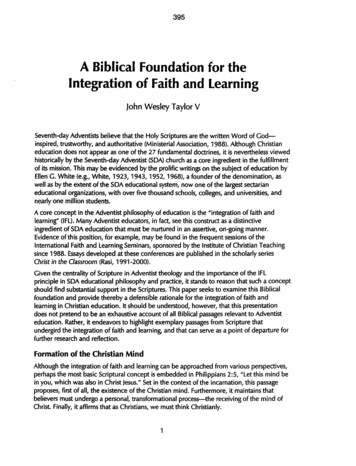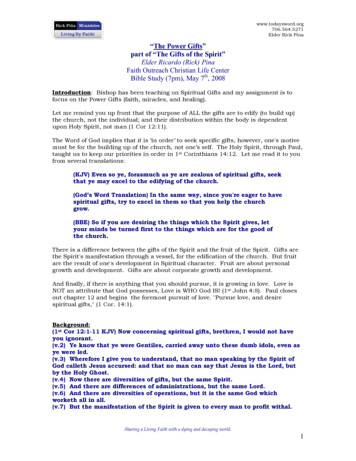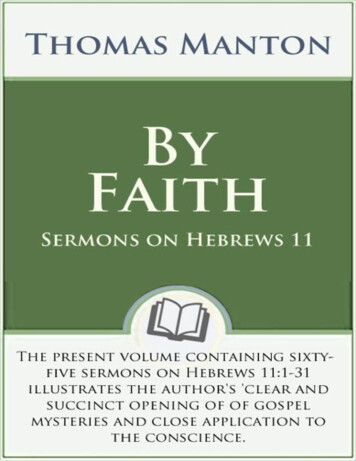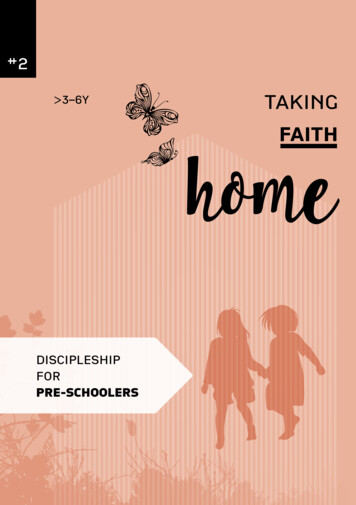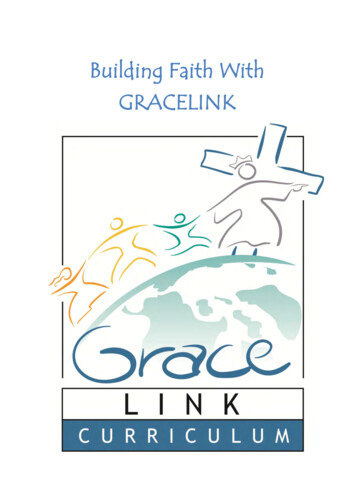
Transcription
Building Faith WithGRACELINK
Contents1.Children’s Sabbath School Job Description2.GraceLink Sabbath School3.GraceLink Overview4.Build Faith 24/7- GraceLink Message Points5.Total Hour Learning6.Making Scripture Stick7.Story Telling For Discipleship8.Teaching Children How to Pray9.Positive Behaviour Management10.Partnering With Parents11.Great Resources12.Children’s Ministries Websites
Children’s Sabbath School LeaderYou have been asked to serve as a Children’s Sabbath School leader. This is a wonderfulopportunity to help disciple children – connecting them to a life-long loving relationship toJesus. The GraceLink Curriculum is used. This has been designed for faith development –Bible-based and focussed on the key understandings and practice of Grace, Worship,Community and Service.This guide has been designed to help you get started in this ministry.Core ValuesJoywe want the children to celebrate who God isSafetywe ensure physical and emotional safetyFamilywe recognise and empower the children’s familySharingwe equip children to share God’s graceApplicationwe plan for a changed lifeEngagementwe encourage active learningRelationshipswe are intentional about building relationshipsAccountable To:Children’s Ministries Coordinator and Children’s CommitteeSpecific Responsibilities: set goals for the Sabbath School organise and lead the Sabbath School – programs/themes coordinate room decorations, purchase and store resources/GraceLink TeachersGuides and children’s Bible Study Guides delegate teacher’s responsibilities and ensure Total Hour teaching happens equip and support teachers by meeting regularly for planning organise yearly Sabbath School training regularly encourage and thank teachers organises volunteers from youth and older members
work with Children’s Ministries Coordinator and children’s committee to set abudget work with Children’s Ministries Coordinator and children’s committee to integrateall church activities and plan a yearly calendar of family-friendly events and parentoutreach Maintain and update children’s files – contact details, attendance, birthdays Ensure volunteers are screened and have completed child-safety forms and roomenvironment is safe.Ministry Coordination Nurturing ministry: Greet and welcome children and parents; send get-welland birthday cards; visit sick children; build strong community; organise weeklysnacks and regular potlucks; ensure children have quality discussion time in groupsof approx. five Serving ministry: Empower children to serve the church, home and community– use ideas from GraceLink Teachers Guide Outreach: Encourage children to invite friends to Sabbath School Family ministry: Organise visitation so that each child receives a home visit atleast once a year; equip and support parents to use Gracelink at home Worship ministry: Choose songs, musicians; provide a place where children canhave a quiet time with God; ensure children, Sabbath School teachers andvolunteers pray for each other and the Sabbath School Mentoring: Children to accept Jesus as Saviour, and put names forward forCommitment Ceremony ; teachers in spiritual growth; parents as they build faithat homeSabbath School leaders must be committed to: Jesus Christ and a growing relationship with HimChrist-centred ministry to childrenThe Seventh-day Adventist Church and its beliefsA balanced Christian lifestyleTeamworkCooperative ministry under the leadership of the children’s ministries coordinator,church pastor and church boardPersonal growth in spiritual formation of children and teaching skills
From the Pen of Ellen G. White. . ."The modes of teaching which have been adopted with such success in the public schoolscould be employed with similar results in the Sabbath-school, and be the means ofbringing children to Jesus and educating them in Bible truth" (Testimonies on SabbathSchool Work, p. 8)."There are among us many young men and women who are not ignorant of our faith, yetwhose hearts have never been touched by the power of divine grace. How can we whoclaim to be the servants of God pass on day after day, week after week, indifferent totheir condition?" (Gospel Workers, p. 207)."Never rest till every child in your class is brought to the saving knowledge of Christ"(Testimonies on Sabbath-School Work, p.13)."To mold and fashion the character of children and youth is a work of the very highestimportance, and in this work it is essential to present Christ in His matchless love to themind, that His counter and stronger charms may eclipse the attractions of the world"(Counsels on Sabbath School Work, p. 52).“The teachers may give character to the work, so that the exercises will not be dry anduninteresting” (ibid, p. 114). (See also pp. 99, 113, 116-118, 166, 167.)"Teachers should strive to realize the greatness of their work . . . , for their work, initsimportance, ranks with that of the Christian minister" (Counsels for Parents andTeachers, p. 498)."The salvation of our pupils is the highest interest entrusted to the God-fearing teacher"(Counsels on Sabbath School Work, pp. 122, 123)."What a child sees and hears is drawing deep lines upon his tender mind, which no aftercircumstances in life can entirely efface" (Child Guidance, p. 199).“He who becomes a child of God should henceforth look upon himself as a link in thechain let down to save the world, one with Christ in His plan of mercy, going forth withHim to seek and save the lost” (Ministry of Healing, p. 105)."The last merciful light, the last message of mercy to be given to the world, is a revelationof His character of love. The children of God are to manifest His glory. In their own life andcharacter they are to reveal what the grace of God has done for them" (Christ's ObjectLessons, pp. 415,416 )“When the time shall come, in the providence of God, for the world to be tested upon thetruth for that time, minds will be exercised by His Spirit to search the Scriptures, even withfasting and with prayer, until link after link is searched out and united in a perfect chain.Every fact which immediately concerns the salvation of souls will be made so clear thatnone need err or walk in darkness” (Testimonies, vol. 2, p. 692, emphasis added).
GraceLink Sabbath SchoolEvery Child a Disciple of JesusConnect to the Heart of Your ChildSay Goodbye to Busy Work and EntertainmentOne Main Message Each WeekGRACEG – God basedR – RelationalA – ApplicableC – ChallengingE – ExperientialTeach How Kids LearnLINKLink children to salvation through Jesusand a help them to make a life commitmentto being His disciple through living a life ofGrace, Worship, Community and Service.“He who becomes a child of God shouldhenceforth look upon himself as a link in thechain, let down to save the world, one with Christin His plan of mercy, going forth with Him to seekand save the lost.” Ministry of Healing p.105
GraceLink OverviewTheology1. Biblically BasedGraceLink is a 12-year curriculum comprising 624 lessons, all of which are firmlygrounded in Scripture. Most lessons are story-based, some on scriptural referencesthat teach a specific doctrine. Each story has been selected to develop one of the fourdynamics of the GraceLink series: grace, worship, community, and serviceBecause each lesson centres on a single message, each telling of a Bible story isfocused – not simply “watered-down”. Often a story is revisited elsewhere in thecurriculum with another point of focus. This is a thematic curriculum; only oneteaching point is make at a time from a specific Bible story.2. Spirit of Prophecy SupportedEvery lesson is supported by the writing of Ellen G. White. The Conflict of the Agesseries is referred to most often. Other references include Steps to Christ, ThoughtFrom the Mount of Blessing, and Christ’s Object Lessons. In some instances quotationsare included within the story; however, in most cases references are included in theTeacher Enrichment section of the teaching guide.3. SDA Bible Commentary UseWriters regularly referred to The Seventh-day Adventist Bible Commentary series tograsp understanding of the message being taught. Editors always referred to thosereferences during the editing process. Quotations from the Commentaries are oftenused in the Teacher Enrichment section of the teaching guide.4. Biblical Research Institute InvolvementDuring the editorial process, all GraceLink manuscripts were reviewed for theologicalsoundness by the director or associates of the Biblical Research Institute at theGeneral Conference. Dr. Angel Rodriguez and his associates gave close attention to alllessons and teaching guides.5. Doctrines and Principles TaughtVirtually every Adventist doctrine is taught at some point during the 12- yearcurriculum. Even very young children learn of baptism by immersion, the state of thedead, the Sabbath, and other essential doctrines. These and others are taught throughstories in coherent thematic clusters and reinforced through activities during theSabbath School hour. The bedrock Adventist message is taught at every level with themost effective methods of instruction.6. Four DynamicsThe four dynamics incorporated in the GraceLink curriculum provide a balanced
program and from the core of the curriculum. These are: Grace (Jesus loves me) Worship (I love Jesus) Community (We love each other) Service (We love you too)7. Bible Story EmphasisEvery lesson in every level of the 12-year program includes Bible study appropriate tothe age of the child. Even children in Beginner Sabbath School learn that the Bible isGod’s Word. Teachers at that level are asked to open their Bibles when teaching thememory verse and show that verse to the children, to identify the Bible as God’s Wordas they use the Bible to teach the memory verse. In addition the teacher is directed toshow the children the verses on which that day’s Bible story is based andto readthose verses aloud, pointing to each word or phrase as she or he reads. Kindergartenchildren also learn that their stories come from the Bible. Primary children learn howto find and read texts that provide a background for the lesson of the day and/or leadto more discussion of the lesson objective. Juniors are directed to individual daily Biblestudy to learn more of the story or to apply concepts taught.8. Outreach – A LifestyleEvery lesson plan includes a section that calls for sharing what the child has learnedwith someone else – a friend, teacher, parent, relative, neighbour, or other personwith whom the child frequently comes in contact. The child is often asked to makesomething in Sabbath School to give that person, and while giving it tell the personsomething about the story or lesson they have studied that day. The goal is to helpchildren become so comfortable with sharing what they have learned that they willcontinue doing so throughout their lifetime.9. Calls for DecisionsThroughout each lesson children are invited to make decisions – how would theyapply concepts studied in their own life? How could they use what they have learnedto help themselves, their families, their friends? Questions such as “What could youdo to . . .” or “How important is this to you and/or your family?” are frequently askedthroughout the entire teaching/learning experience each week.Educationally SoundThe production of the original curriculum plan and outlined the teaching methods tobe used. For the first time in the history of Adventism, Sabbath school lessons forchildren have been formulated with the use of current educational theory andmethods. Curriculum consultants directed Writers from every world division followedthese plans as they participated in the development of lessons. Same message – newmethods.
1. Total – Hour TeachingPast programming for children’s Sabbath School was rarely designed to complementthe topic of the lesson for the day. About 40 minutes was spent on material unrelatedto the lesson topic. At the most, younger children spent 15 to 20 minutes sitting intheir chairs, listening to a teacher tell the lesson story as she or he placed felts on afelt board. The GraceLink curriculum provides total – hour teaching, in which everyactivity focuses on the central message of the Sabbath School lesson for that day.Objectives are clearly stated in the teaching guides. Activities are carefully outlined toteach to the stated point of the lesson. The entire lesson focuses on one carefullydetermined objective for the day.2. Active ProgramsToday we know that we must approach learning activities through a variety ofmethods. Thus today’s Sabbath School classes often nurture and exuberantatmosphere in which children actively pursue learning under the direction of a leaderor teacher.This process deals with knowledge, emotion, and application. Educational researchtells us that people remember more when they are emotionally involved and thatpleasant emotions enhance positive learning. Debriefing is essential to active learning.It is the means by which children (and adults) understand and apply what they havelearned.3. Learning StylesEducational research has determined that individuals learn best through a particularstyle or way of learning. Although each person may use all four of the identified stylesor ways of learning at one time or another, most of us depend on one majorapplication. These four learning styles are incorporated into every GraceLink lesson.This makes it possible for every child to grasp the point of the lesson and tounderstand it in her or his own way.4. Inclusive ArtThe goal of the art in GraceLink, provided expressly for children by illustrators whospecialize in art for children, is to provide a bias-free visual commentary integral to thetext. People are depicted in a way that captures attitudes, personality, and ideas – tobe symbolic of the points the lesson is trying to make. More “realistic” representationsof people, which usually depict one culture or ethnic group to the exclusion of others,are avoided. Realistic, full-colour detail is used, however, in depicting cultural detailsof life in the Middle East during Bible times, such as the kinds of ovens used in thebaking of bread.
Dynamic 24/7 FaithGRACE: Jesus loves me.We want for our children the peace that comesfrom growing up in a spiritual atmosphere foundedupon, saturated with, and characterized by grace.In this atmosphere our children can learn howmuch Jesus loves them. They discover how Hewould have died for them even if they had beenthe only one who needed His help.What it meansThey’ll learn He has prepared a home for them in His eternal kingdom. They’ll come toappreciate that this eternal home is a gift from the goodness of Jesus – that can’t beearned. We believe that God’s grace is sufficient for all our needs – that a matureChristian experience needs no other motivation and power than the grace of Jesus.We believe that grace is the power behind “the good works that Christians do,” eventhough we do not believe that “the good works that Christians do” earn salvation.What to doThrough our lessons and children’s stories we want to impart the full impact of a graceorientation. Discussions about salvation will emphasize the actions of God toward us.WORSHIP: I love Jesus.We are eager for our children to discover the joyof worshipping God. This joy is often evident intimes of worship: family devotions, SabbathSchool meetings, and church services.What it meansWe also want our children to know that everymoment of their lives can be a happy response toGod’s grace. Relations with mothers, fathers,sisters and brothers, teachers, classmates, andfriends can praise God as well as promote harmony.Our social activities reveal the God we worship as well as provide happy recreation. Ourhelpful activities can point people to Jesus as well as encourage others.We believe that a maturing faith responds to and is empowered by God’s grace in everyaspect of our lives. That faith affects every aspect of our lifestyle and choices, and resultsin an abundant life, full of joy here on earth.What to doIn our children’s stories and lessons, we must not separate the spiritual parts of our livesfrom the rest of what we do. All our children’s activities must be open to the leading ofGod.This is also a primary reason why we use contemporary versions of the Bible. Childrenneed to hear God’s Word in everyday language and know that they can speak to God as afriend.
COMMUNITY: We love each other.We want to create for our children a genuinecommunity of faith in which their Christianexperience can fully develop. We understand thatthis requires a modelling of God’s grace that isaccepting, non-judgemental, and forgiving.What it meansA genuine community of faith purposefully involvesour children in spiritual life at home and in church. Afaith community will actively challenge prejudice a division between gender, racial, ethnic,socio-economic, and age groups.It means encouraging children’s exploration of their own faith; and providing creative,thought-provoking challenges to spiritual growth. We should also teach our children howto support their faith community with their prayers, financial support, and participation.We believe that a faith community begins in the home, is nurtured through Christianeducation, and is the vision in which all our churches seek fulfilment.What to doOur children’s lessons and stories need to help create a positive faith developmentclimate. Through words and illustrations, we want to actively involve our children in theirown congregations.We want to see them taking part, asking questions, being warmly received as fullmembers of their church, making contributions, and discovering answers.SERVICE: Jesus loves you, too.We want our children to experience the profoundsatisfaction that comes from a life of service toothers - fulfilling our church’s mission in our homes,our neighbourhoods, our nation, and the world. Suchsatisfaction comes from experiencing the joy ofservice. It is our responsibility to help facilitate themotivation and opportunities for service.What it meansWe can teach our children the blessings of servingGod by their being faithful in little things. Teach themthat everyday duties can be acts of devotion, and that each person has a special work inGod’s plan.We can model faithfulness by extending hospitality, encouraging others with kindness,and attending to the physical needs of others. From their earliest days, our children needto know how special it is, how Christ- like, to be a servant.What to doWe believe that a grace orientation motivates us to serve others. Children who learn thejoys of service experience a level of faith maturity that encourages a lifetime of service forGod. We want to help our children personally discover this joy.
1. In Total hour learning the entire Sabbath School time is a complete learning cycle,teaching and reinforcing the point/message of the lesson. The time is not brokeninto program and class segments. The “Hour” is divided into four segments, eachone of which appeals most strongly to a specific learning style. Taken in sequence,however, these segments follow the pattern of how the brain learns best. Theyanswer the learning questions Why? What? How and What If? ( In otherdiscussions referred to as the learning styles.)2. The first segment of the “hour” involves an activity or activities which capture theattention and connect students emotionally with the topic for the lesson. Thesereadiness activities are usually quite active and reach the students on more thanone level of perception. These activities lead students to understand Why? theyshould learn the lesson, and to engage their feelings as well as their thoughts.3. The second segment answers the learning question What? Even this traditionalaspect of the learning cycle – the subject matter – takes on an additional colour asstudents learn the Bible story interactively (having some active part in the learningexperience, and being engaged, not just as passive listeners).4. The third segment of the total hour answers the question How? How does thisapply to my life? Inspire the children to apply the Bible story. The students are able
to discuss a situation in contemporary life when the lesson’s principle applies.5. The fourth segment of the hour deals with what the student can do with thenewly learned concept to bless others in the coming week. What if. . ? is thetypical learning question. Children leave the Sabbath School ready to share themessage learned.6. In GraceLink curriculum there is also guidance given for the time-honouredbusiness of Sabbath School, such as prayer, mission story, offering, and songservice. This segment can be incorporated wherever the leader feels it works best.However, it is recommended that the Sabbath School hour begin with readinessactivities.Involve Children Actively in their LearningWe know that children remember about 30 to 35 percent of what they hear, about 40 to50 percent of what they see, and about 90 percent of what they do. The emphasis inGraceLink is placed on all three. Children are often guided through activities thatincorporate hearing, seeing, and doing – and require activity“Tell me and I’ll forget.Show me and I may remember.Involve me and I’ll understand.”Multisensory LearningUse as many senses as possibleVisual – I learn what I see. I like pictures, video clips, posters, charts and I like drawing andcreating.Auditory – I learn what I hear. I like listening to stories and tapes, taking part indiscussions, listening to and taking part in plays and readers’theatre.Kinesthetic – I learn when I move. I love drama, mime, service projects, field trips,activities that involve large body movements.Tactile – I learn what I touch and manipulate. I love crafts, playdough, art projects, writingand recording.Dig Deeper With Thinking-– Discussion and questioningThinking/Debriefing questions follow activities in every segment, but are particularlyimportant here. Through these prompts for discussion, the leader/teacher is able to askquestions that invite the students to reflect on what they experienced (reflective), what itmeans to them (interpretative), and what they can do about it (applicable). The debriefingtime is what makes the activities educative and not just activity for activities sake.Debriefing ActivitiesDebriefing helps children process what they learned.
a. Talk about what they did Ask the kids to show what they made or created Let them tell what they intendedb. Talk about what they learned Ask how they feel about the activity Ask what they learned from the activityc. Relate the activity to the Bible Ask what the activity tells them about the Bible verse Ask, “What might God be telling us through this story?”d. Help them apply what they learned to real life today Share what they learned Act on what they learnedBuild RelationshipsBefore we can connect children to Jesus, we need to ensure that they are connected to usand that we spend quality time building relationships and talking with them. Childrendevelop faith in the context of trust. Ensure that the precious time that we have withchildren is not wasted spending time in preparing resources. Chat and have fun.Partner With ParentsParents are the Key disciple makers of their children and it is essential that we partnerwith them – equipping and empowering them for the important faith development thathappens 6 days a week. (NB resource booklet on ideas for Partnering With Parents)Sabbath School Organization QuestionsWhat are the recommended age levels for each division?Beginnerages 0-22 year cycleKindergartenages 3-52 year cyclePrimaryages 6-94 year cycleJunior, Powerointsages 10-124 year cycle (grades 5-6)Teens, Real Time Faithages 12-142 year cycle(grades 1-4)Ours is a small church; how should we handle combining some classes?Every church should feel empowered to divide the children according to the local needs.For instance, if you have only a few babies in Beginners and too many 5 year olds for thespace in Kindergarten, you may want to keep 3 year olds in Beginner. (More on combineddivisions at www.gracelink.net ) Smaller churches may need Kindergarten and Beginnerclasses combined. They can then use the Kindergarten programs in Sabbath School. In theGraceLink curriculum, the Beginner lesson each month is one of the weekly Kindergartenstories. Most 6 year olds are ready for the challenge of being in Primary, and do notbelong in Kindergarten. The GraceLink Kindergarten lessons are designed for 3-5 yearolds. Small churched that have only a few Juniors may have them help teach the smallerchildren, and provide a special program just for the Juniors after the potluck lunch or onFriday night.
Making Scripture StickOur aim is to help children enjoy learning God’s Word and to be able to apply it totheir lives.1. God's word commands it! Deuteronomy 6:6,7These commandments that I give you today are to be upon your hearts.Impress them on your children. Talk about them when you sit at home andwhen you walk along the road, when you lie down and when you get up.2. It's valuable. Psalm 119:9,11"How can a young man live a pure life? By living according to God's Word. Ihave hidden your word in my heart so that I might not sin against you."3. Verses committed to memory as a child may be drawn on in later life.4. They will guide and give direction to a child's life. Psalm 119:105"Your word is a lamp to our feet and a light to our path."TipsI. Be thoroughly prepared and know how to use your materials/visuals.2. Always have your materials made before class.3. Use a variety of methods. Surprise adds excitement.4. The activities should be fun and easy, not challenging.5. Be enthusiastic.6. Use lower case letters for young children.7. Emphasize the central theme of the verse.8. Use a Bible so that the children associate the verse with the Bible.9. Repetition is essential. Repeat verse at least 6 times throughout the meeting.10. Stress the doing, not just the knowing, of the verse.11. Give them something to take home to remind them, eg, fridge magnet12. Take no longer than 8 minutes to teach the verse.13. Always encourage the children.14. Use both audience participation and competition.15. Provide mental relaxation after learning the verse eg, sing familiar song16. To answer questions children must raise hands and remain seated. This willassist in maintaining control.17. Question all children, not just the 'brighter' ones.18. Treat all answers seriously.
HOW?BeginnersPraise the child for whatever response he or she makes. Some childrenmay not be ready yet to try memorizing i n class. Spend one month onone verse.Reading from the Bible. The child "helps" an adult read theverse from the Bible, exaggerating emphasis on key words.Echoes. The child echoes each phrase right after the adult says it.Bible verse songs. Sing the song often in class until the children pick itup. The music aids memorization.Action songs. Make up actions to sing with the song and the childrenwill enjoy the verse more and learning it sooner.KindergartenReading from the Bible. The child holds the Bible while adult points to thewords and reads, even though she cannot read. Do this after eachactivity and story throughout the entire program. Soon, the child willcomplete the verse after hearing the first couple words. Prompt asnecessary. Praise extravagantly.Tell Your Arms. After the children begin to learn the verse, ask them totell their arms. As they say each word, they pat alternate arms with theopposite hands. When they get the hang of this, speed it up. Vary it with"tell your shoulders" (tap alternate shoulders), "tell your head" (nod headfrom side to side), "tell your knees" (tap alternate knees), and “tell yourfeet" (stand up and tap alternate feet).Rhythm Band. Kids tap rhythm instruments as they say the verse. Theymay even march as they play and say.Memory Lane. Cut out colorful foot prints and laminate them. Tapefootprints on the floor, one for each word of the Bible verse, spacedto form a pathway for one child at a time to walk. Kids line up and taketurns to say the verse, taking a footstep for each word they say. Ifthey miss a word, prompt them and then let them start over.Primary - JuniorIf the memory text i s read after each activity and the Bible story, thechildren soon memorize it and are ready for a memorization game. Do notask them to say the verse just for the sake of saying it. Occasionally, you
can ask juniors to set the song to music and sing it to the class, say it withrhythm, or make a poster or door hanger that features the text.Flash Card Games. Flash cards are index cards with a single. Different word of thetext written on each. [The larger the group, the larger the cards need to be andthe thicker the marker that you write with.]Scrambled Verse. Hand out flash cards in random order. Kids arrange themselves inorder of the verse and say the verse, each child saying the word they hold, and thensay the verse all together.Bible Search. Give kids the flash cards and the reference. They look up their Biblesand then assemble the verse.Missing Words. The flash cards are in order where everyone can see them. Haveeveryone read the verse, and then remove one card. Everyone reads the verse,supplying the missing word. Repeat, each time removing one more card until there areno cards and kids can say the whole verse by themselves.Missing Word Snap. Now say the verse from memory, deleting the first word andsnapping fingers in place of the deleted word. Repeat, each time deleting andsnapping for one more word. Works best for shorter verses.Bible Stepping Stones. You need the memory verse on flash cards, one word per card.Arrange the words upside down on the floor, in order and only a step apart. The kidssay the word and then step on the flash card before saying the next word of theverse. You can mix it up with the trail from the previous memory verse crisscrossing
(Testimonies on Sabbath-School Work, p.13). "To mold and fashion the character of children and youth is a work of the very highest importance, and in this work it is essential to present Christ in His matchless love to the mind, that His counter and stronger charms may eclipse the attractions of the world" (


